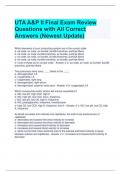UTA A&P II Final Exam Review
Questions with All Correct
Answers (Newest Update)
Which elements of your conducting system are in the correct order:
a- sa node, av node, av bundle, bundle branches, purkinje fibers
b- sa node, av node, bundle branches, av bundle, purkinje fibers
c- av node, sa node, av bundle, bundle branches, purkinje fibers
d- av node, sa node, bundle branches, av bundle, purkinje fibers
e- none of these are in correct order - Answer ✔ a- sa node, av node, av bundle, bundle
branches, purkinje fibers
The pulmonary veins carry ____ blood to the ____
a- deoxygenated, LA
b- oxygenated, LA
c- oxygenated, right lung
d- deoxygenated, right atrium
e- deoxygenated, superior vena cava - Answer ✔ b- oxygenated, LA
Which compounds and/or factors will induce vasodilation?
a- NO, low pH, high CO2, high K
b- NO, high pH, low CO2, low k, histamine
c- NO, low pH, low O2, high K, histamine
d- NO, prostaglandins, histamine, thromboxane
e- high O2, low CO2, high K, histamine, low H - Answer ✔ c- NO, low pH, low O2, high
K, histamine
As blood circulates from arteries into capillaries, the total cross-sectional are of
capillaries:
a- decreases and causes the blood velocity to increase
b- decreases and causes the blood velocity to decrease
c- increases and causes blood velocity to decrease
d- increases and causes blood velocity to increase
e- same as the total cross-sectional area of the arteries and blood velocity is equal
between arteries and capillaries - Answer ✔ c- increases and causes blood velocity to
decrease
,Sympathetic input to the smooth muscle tissue in bronchioles causes all of these
except:
a- less airway resistance
b- relaxation
c- a bigger lumen
d- bronchiodialation
e- bronchoconstriction - Answer ✔ e- bronchoconstriction
Damage to the type II alveolar cells would result in
a- a loss of surfactant
b- an increased rate of gas exchange
c- increased surface tension in the alveoli
d- increased tendancy to alveolar collapse
e- A, C, and D - Answer ✔ e- A, C, and D
The chloride shift is defined by ___ moving out of red blood cells in exchange for ___
moving into the red blood cells.
a- bicarbonate ions, chloride ions
b- chloride ions, bicarbonate ions
c- chloride, co2
d- oxygen, chloride
e- co2, chloride - Answer ✔ a- bicarbonate ions, chloride ions
This hormone functions to counteract the effect of gastric acid in the SI
a- pepsin
b- gastrin
c- secretin
d- enteropeptidase
e- carbonic acid - Answer ✔ c- secretin
Which region of the stomach does the esophagus connect to?
a- fundus
b- pyloris
c- cardia
d- body
e- antrum - Answer ✔ c- cardia
All of the following are true of the secondary response to antibody-mediated immunity
EXCEPT that:
a- it results in much higher antibody titers (numbers) than in the primary response
b- it produces more effective antiboides (more IgG than IgM)
c- it depends on memory B cells
d- the response time is much faster because memory cells do not need second
activation signal
e- it weakens quickly because memory B cells only survive for a year or two - Answer ✔
e- it weakens quickly because memory B cells only survive for a year or two
, Air moves into the lungs when the pressure inside of the lungs is:
a- less than the pressure in the atmosphere b/c the diaphragm contracted down
b- greater than the pressure in the atmosphere b/c the diaphragm contracted up
c- equal to the pressure in the atmosphere
d- greater than the pressure in the atmosphere b/c the diaphragm contracted down
e- less than the pressure in the atmosphere b/c the diaphragm contracted up - Answer
✔ a- less than the pressure in the atmosphere b/c the diaphragm contracted down
All of the following are true of beta-oxidation, EXCEPT that:
a- fatty acids break down into two-carbon fragments that enter the kreb's cycle
b- it occurs in the mitochondria
c- it yields a large amount of ATP
d- lipids are converted into glycogen molecules
e- it requires coenzyme A - Answer ✔ d- lipids are converted into glycogen molecules
Match the antibody (Ab) to it's main function:
1. IgA
2. IgM
3. IgE
4. IgG
5. IgD
a. agglutination
b. secreted Ab found in breast milk, tears, saliva
c. precursor Ab
d. most abundant Ab in blood, can cross the placenta
e. Ab responsible for allergies
A- 1d, 2e, 3b. 4c, 5a
B- 1a, 2e, 3c, 4b, 5d
C- 1b, 2c, 3d, 4a, 5e
D- 1e, 2b, 3a, 4e, 5c
E- 1b, 2a, 3e, 4d, 5c - Answer ✔ E- 1b, 2a, 3e, 4d, 5c
Match the proenzyme (1-3) with the correct enzyme activator(4-6):
1. pepsinogen
2. trypsinogen
3. procarboxypeptidase
4. enteropeptidase
5. hydrochloric acid
6. trypsin
a- 1 and 5, 2 and 4, 3 and 6
b- 1 and 4, 2 and 6, 3 and 5
c- 1 and 5, 2 and 6, 3 and 4
d- 1 and 4, 2 and 5, 3 and 6
e- 1 and 6, 2 and 5, 3 and 4 - Answer ✔ a- 1 and 5, 2 and 4, 3 and 6




